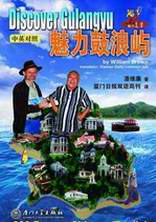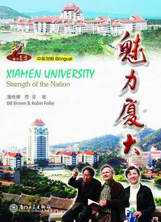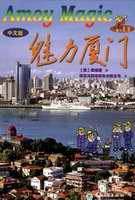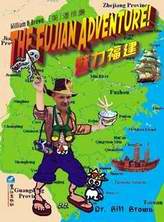![]() Click
to
Access
Click
to
Access
OUTSIDE China
![]() Click
to Access
Click
to Access
INSIDE
China ![]()
TRAVEL LINKS
![]() Xiamen
Xiamen
![]() Gulangyu
Gulangyu
![]() Jimei
Jimei
![]() Tong'an
Tong'an
![]() Jinmen
Jinmen
![]() Zhangzhou
Zhangzhou
![]() Quanzhou
Quanzhou
![]() Wuyi
Wuyi
![]() #1Fujian
Sites!
#1Fujian
Sites!
![]() Fujian
Foto Album
Fujian
Foto Album
![]() Books
on Fujian
Books
on Fujian
![]() Readers'Letters
Readers'Letters
![]() Ningde
Ningde
![]() Zhouning
Zhouning
![]() Longyan
Longyan
![]() Sanming
Sanming
![]() Putian
Putian
![]() Bridges
Bridges
![]() Travel
Info,
Travel
Info,
![]() Hakka
Roundhouses
Hakka
Roundhouses
![]() Travel
Agents
Travel
Agents
MISC. LINKS
![]() Amoy
People!
Amoy
People! ![]()
![]() Darwin
Driving
Darwin
Driving ![]()
![]() Amoy
Tigers
Amoy
Tigers
![]() Chinese
Inventions
Chinese
Inventions
![]() Tibet
in 80 Days!
Tibet
in 80 Days!![]()
![]() Dethroned!
Dethroned!
![]()
![]() Misc.Writings
Misc.Writings
![]() Latest
News
Latest
News
![]() Lord
of Opium
Lord
of Opium
![]() Back
to Main Page
Back
to Main Page
![]() Order
Books
Order
Books![]() Xiamenguide
Forum
Xiamenguide
Forum 
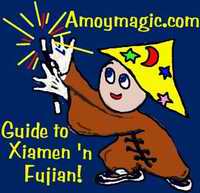
 mouth
of the Jiulong (Nine Dragon) River, so in ancient times she was called
Xia Men, or "lower gate to the sea." Inevitably, Xiamen became
a haven for pirates and merchants (roughly the same occupation). Eventually
the name was amended to the present Xia Men, or "Mansion Gate,"
which also means "Gate to China"-a title Xiamen well deserved
for hundreds of years because Fujian Province, and especially Quanzhou
to the north of us, was the Melting Pot of Asia. (see page 85).
mouth
of the Jiulong (Nine Dragon) River, so in ancient times she was called
Xia Men, or "lower gate to the sea." Inevitably, Xiamen became
a haven for pirates and merchants (roughly the same occupation). Eventually
the name was amended to the present Xia Men, or "Mansion Gate,"
which also means "Gate to China"-a title Xiamen well deserved
for hundreds of years because Fujian Province, and especially Quanzhou
to the north of us, was the Melting Pot of Asia. (see page 85).
China-Ancient
and Ageless
The weight of the past is mindboggling in China. For Americans, an antique
is a Barbie doll from 1959; for Chinese, it's a 2,000 year old brass horse-or
even the woks and pans they cook with!
Sichuan sauces get tastier over time because the saucepots are never washed.
Xiamen University's famed artist Tang Shao Yun told me that his family's
sauce is 14 years old, and that a Chengdu family's sauce has been seasoning
for over 200 years. The saucy rascal grinned slyly and said, "Their
sauce is older than your country!"
An ancient nation sees age differently.
On August 11, 1990, China Daily announced "China's Ten Outstanding
Young People." One outstanding youth, Nie Weiping, world champion
of go chess, was 39 years old.
Ponce de Leon, eat your heart out.
Fair Fujian is an ancient land,
but not much is known of the original Min People because they left no
written records, other than some Shang Dynasty (16th-11th century B.C.)
pictographs carved into a rock in the village of Hua'an. They also left
some strange relics, like 4,012 year old boat-shaped tombs perched hundreds
of feet high on the side of Wu Yi Mountain's vertical
cliffs. I've been dying to know why they made tombs like that. Better
yet, how'd they do it? It's a real cliffhanger of a puzzle. Had Eric von
Danaken (author of "Chariots of the Gods,") seen them, he'd
have easily concluded that ancient extraterrestrials made frequent stopovers
in Fujian, probably for Chinese take-out. Maybe NASA thinks so too. NASA,
having failed to find intelligent life on earth, is seeking it in outer
space by sending interstellar greetings in many earth languages. Their
message in the ancient Amoy dialect goes,
"Friends of space, how are you all? Have you eaten yet? Come visit if you have time."
Maybe ET will come pay his respects to Wuyi's cliff tombs.
Drawn to Chinese Eventually some
ancient Chinese wit discovered how to write--or at least how to draw better,
for modern Chinese characters are still pictographs--(read "Mad
About Mandarin") and began recording Fujian's history back around
the Warring States Period (475 - 221 BC). The Warring States Period was
when the State of Yue (present-day Jiangsu and Zhejiang Provinces) was
going at it with the State of Chu (Hubei and Hunan Provinces). After Chu
chewed up Yue, Yue hightailed it off to Guangdong, Guangxi, Vietnam, and
Fujian, where they were called the Min Yue.
The Min were fair Fujian's first
folk, but nowadays they share our province with nationalities like the
She, which are a clan of the Miao tribe. Originally from the Yangtze River
Valley, the She claim descent from a legendary emperor-hence their unique
'phoenix clothing' and 'phoenix hairstyles' (Chinese mythology associates
phoenixes with royalty).
Fujian is also home to the Dan tribe, whose Mongol ancestors made the long trek to Fujian about 700 years ago. The Dan are no relation to the Israelite tribe of Dan, though China does have enough Chinese Jews scattered about that some experts claim they are remnants of the Lost Tribes of Israel. And given the state of our local maps, I can see how they got lost. There was at least a small community of Chinese Jews in Quanzhou at one time, but whether the Lost Tribes are still wandering about China or not, the Lost Arabs certainly are.
Quanzhou
once had at least 40,000 Muslim Hui, and now has communities of Ding and
Guo descended from Arab and Persian traders in ancient Zaitan (what Marco
Polo called Quanzhou). With their curly
hair and hooked noses, the Ding and Guo look more Laowai than Laonei.
And it appears that Chinese Arabs are just as zealous as their Middle
Eastern cousins.
Back when Iran was after Salman Rushdie's hide for writing the heretical
"Satanic Verses," Chinese Moslems in N.W. China were after a
Chinese writer's neck for the same crime-heresy. With so much running
after folks, I guess that is why back in 1935 some wit changed Persia's
name to "Iran."
Whether lost Jews or running Arabs, Abraham's descendants add a lot of color to Fujian, but just as fascinating are the Chinese Hakka ("guest families"). Over 1,000 years ago, entire villages of Hakka emigrated en masse from the Central Plains to remote areas of Fujian, where for hundreds of years they have faithfully preserved their unique language, costumes, customs, and cuisine. The Hakka now number about 60 million, and include among their luminaries such famous folk as Sun Yat-sen and his wife Soong Ching Ling.
The
Legendary Chinese Jews
Jews probably first made their way towards China during the Babylonian
exile 2500 years ago, when trade with China was already well established,
but a 718 A.D. business letter, written on paper in the trade language
of Judeo-Persian, is the first proof on paper (because paper was produced
only in China).
In the late 9th century, ibn Khurdadbih, the "Postmaster of Baghdad," spoke of Jewish traders (Radanites) who traveled from Spain and France to China and back via land and sea. Marco Polo met Chinese Jews in Beijing around 1286, and in 1346, the Muslim traveler ibn Battuta entered Hangzhou through the "Jew's Gate. He wrote of "Jews, Christians and sun-worshiping Turks, a large number in all."
During
the mid 16th century, a Portuguese traveler wrote of China's "Moores,
Gentiles, and Jewes, have all theyr sundry oathes," and that China's
judges had them swear in courts "by the thynges they do worshyppe."
Matteo Ricci, the famed Catholic missionary, is credited with discovering
the Kaifeng community of Jews, but they found him-and thought he was a
Jew!
A Jewish Chinese mandarin, Ai Tian, left Kaifeng in June, 1605, seeking
a better post in Beijing and a meeting with Ricci. Ai had read about Ricci's
monotheism, and since Ricci stubbornly denied being a Moslem, the Chinese
Jews had concluded he must be a Jew.
Ricci was thrilled to meet Ai, and since Ai was a monotheist but stubbornly denied being a Moslem, Ricci concluded he was a Catholic. Ricci led him into the church (which Ai thought was a synagogue), and knelt before paintings of Mary and the baby Jesus, and a young St. John. Ai decided they must be Rebecca, Jacob and Esau, and the ever courteous Chinese politely knelt. He remarked that his people did not genuflect, but he had no objections to Ricci's peculiar method of honoring ancestors.
Ai saw a painting of Matthew, Mark, Luke and John and asked why the painter didn't include Jacob's other sons. In the end they resolved the misunderstanding-to both party's delight. Though the Jews apparently still considered the Catholics a mere variation of Judaism.
In
a 1608 letter to Ricci, the elderly rabbi of Kaifeng's synagogue (built
back in 1163) objected to Ricci's insistence that the Messiah had already
come. But he said their other differences were minimal, and he suggested
that Ricci succeed him as chief rabbi of Kaifeng-provided that Ricci first
quit pigging out on pork.
Kaifeng's Jews are thought to have originated from either the area of
Persia or else India, Bukhara, or Yemen. The fact that Quanzhou and other
coastal cities had Jewish communities suggests they arrived by sea, as
traders, rather than overland. But the Ming shut down the silk road and
the silk sea, and the Jews succumbed to isolation (though they were never
persecuted by the Chinese, as they were in almost all other nations).
Today,
the Kaifeng street on which hundreds of Chinese Jews still live is named,
"The Lane of the Sect that Teaches the Scriptures."
But no lox and bagels
Xiamen on the
Rise While Jews and Arabs and Mongols and Han Chinese were wheeling
and dealing and doubledealing, Xiamen Island was in the throes of a deadly
battle for supremacy between egrets and poisonous snakes. Or so the legend
goes. The Egrets won, earning Xiamen one of its many nicknames, "Egret
Island." Xiamen also had tigers right up until the 40s, but today
only 80 Amoy tigers remain in the wild, and none on Amoy Island. (But
we do have rare white dolphins frolicking in our bay).
Neither slithery snakes nor imperious egrets kept away Song Dynasty farmers who were so pleased with their rice crops that they nicknamed Xiamen "Jiahe Island," meaning "Isle of Abundant Crops." At that time, our verdant island was under the jurisdiction of Tong'an County, Quanzhou Prefecture. Nowadays the tables have turned, and Tong'an is part of Xiamen County (and glad of it, given Xiamen's deep pockets).
Imperial troops were stationed on Xiamen back in 1058 (Song Dynasty), and in 1282, 1,000 soldiers oversaw political and military affairs in the "Thousand Households District."
As
a defense against Japanese invasion, Prince Zhou Dexing enclosed "Xiamen
Town" with 110 km. of heavily fortified walls, and divided the 4,000
households into 22 wards governed by a city council. Sadly, that ancient
wall was razed in 1928, but a few remnants remain here and there (Xiamen
University has one).
China managed to fend off the Japanese fairly well, but Europe's Laowai
were another matter. Portuguese began trading with Xiamen in 1516, and
Zhangzhou and Quanzhou merchants, eager to resume the trade halted by
the emperor a century earlier, began smuggling with the foreign devils
on the island of Wuyu, at the entrance to Xiamen harbor.
The Spanish followed the Portuguese in 1575 with a mission from Manila to Fuzhou. When Fuzhou showed them the door, they turned their wills and wallets to Xiamen, where locals would do anything for a peso. And the rush was on. The Dutch followed the Spaniards in 1604, and after seizing control of Taiwan in 1624, they began smuggling silk and sugar between Taiwan and Jinmen Island (an island now controlled by Taiwan and only a few miles off shore). But the silk and sugar trade proved neither smooth nor sweet once Koxinga came aboard.
Koxinga
Pirate-Cum-Patriot
(Click Here for excerpts from "Koxinga"
chapter of "Discover Gulangyu").
Every ship entering Xiamen Harbor is greeted by a massive statue that
locals swear protects our port from rough seas and weather. The statue
is of Zheng Chenggong (1624-1662), or Koxinga (Coxinga) as the Dutch called
him-the pirate-cum-patriot who became one of China's most revered heroes.
Koxinga learned his trade from dad, Zheng Zhilong, who in his youth studied foreign trade in Macao, then sailed to Japan to apply Portuguese trade principles to piracy. Somewhere in Zhilong's busy pirating schedule he found time to marry a Japanese maid, Miss Tagawa, who bore a son: Fu Song, aka Zheng Chenggong, aka Koxinga.
After
a stint of piracy in Taiwan, Zhilong returned seven year old Koxinga to
Nan An, his hometown, for schooling. Like fathers before and since, he
wanted his son to have what he did not have as a youth-namely, lots of
homework.
Koxinga was indeed quite the scholar. He survived school and homework,
and at age 21 headed off to Nanjing State College, never dreaming that
his future lay not in scholastics but in piracy and politics-thanks to
the militant Manchus.
After a peasant army overthrew the Ming dynasty, the Manchus waltzed into
the power vacuum and created the Qing Dynasty. Their arrogance angered
the Hans, who like most homo sapiens deeply resented any arrogance but
their own. They rebelled-futilely. After a fight in Fuzhou in 1646, Tagawa
(Koxinga's mother) committed suicide, and Koxinga's father surrendered.
Filial piety dictated that Koxinga also throw in the towel, but for unclear
reasons he parted ways with his father and remained loyal to the Ming.
And what better place to base his anti-Ming army than the very Gateway
to China - Xiamen?
Koxinga changed Xiamen's name (yet again?) to Siming ("Remember the
Ming"), and even today one of Xiamen's main thoroughfares is called
Siming Rd.
Gulangyu Islet's Sunlight Rock became Koxinga's command center, as well as training grounds for his legendary fighters. I once courted a hernia by hefting an ordinary soldier's 80 pound iron lance. But Koxinga's personal troops made ordinary soldiers look like Cub Scouts. He chose as his body guards ("Tiger Guards") only those who could pick up a 600 pound iron lion and walk off with it.
Koxinga's legendary fighters wore iron masks and iron aprons, wielded bows and arrows painted green, and used long handled swords for killing horses-a brilliant strategy he learned in school days while studying about the Great Wall. (The Great Wall was built to keep out not the barbarians but their horses, for while the Tartars were well nigh invincible on horseback, on foot the Chinese easily made Tartar sauce out of them).
For
years, Koxinga raised the battle cry "Remember the Ming," but
on April 21, 1661, he set sail with 25,000 men and hundreds of war junks
to drive the Dutch from Taiwan and return the island to the motherland.
This mission cost him his life, but forever endeared him to Chinese on
both sides of the straits.
On January 27, 1662, the Dutch surrendered their prize of 38 years. Chinese
on both sides of the straits rejoiced, and Koxinga's men kicked back and
played the "Mooncake Gambling Game" (you will too if you're
in Xiamen or Taiwan during Mid-Autumn Festival). But patriotism had taken
a greater toll on Koxinga's health than piracy had. He died five months
later, on June 23.
One Chinese historian noted somberly that Koxinga "died of overwork."
May it be a lesson to us all.
Crashing
the Gate-Both Directions
Taiwan's return to the motherland was a windfall for traders in neighboring
Xiamen, which was soon the choice port of call for hundreds of Chinese
and Portuguese merchant ships. In 1684, the Qing government finally legitimized
Xiamen's title of "Gateway to China" by establishing a customs
house. The British and then the Spanish flooded into Xiamen, and by the
early 1700s, even the once reviled Dutch won a warm reception, coming
this time as merchants, not conquerors (there's a lesson in there somewhere).
While we foreign devils were flooding in, the Sons of the Dragon were
flooding out, much to the Emperor's dismay.
As early as 1728, the Emperor tried to halt mass emigration of Fujianese
with a proclamation warning that Chinese who did not immediately return
to China would be banished or, if caught, executed. But naught stemmed
the tide-in either direction.
By the mid 19th century, there were two and a half times more overseas Chinese of Xiamen origin than there were actual Xiamen inhabitants. Today, Xiamen is an ancestral Mecca for 350,000 overseas Chinese, and over 70% of Taiwan residents trace their origins back to Southern Fujian - which helps explain why Xiamen and Taiwan people are so alike in their local dialect, dress, customs and cuisine. But the real problem was not Laonei flooding out but Laowai flooding in…
Putting the Dragon to Sleep Click Here for "Lords of Opium" By the 1750s, Xiamen was booming, and the once placid harbor was wharf-to-wharf foreign ships, but the Qing placed a higher priority on stability and cultural integrity than mammon. China unceremoniously ousted the entire rascally bunch of Laowai, and ancient Amoy was once again the sole province of farmers, fishermen, and gardeners - but even so exerted an influence that helped pave the way for American independence.
No Xiamen--no U.S.A.!! At midnight, December 16, 1773, irate colonists decked out as Indians boarded a British ship and tossed 342 chests of Anxi tea from Xiamen into Boston Harbor. So had it not been for Xiamen, American soldiers would still be wearing red coats, and lawyer's would be decked out in white-powdered wigs. But Britain got revenge for losing America by seizing Xiamen and the rest of China-not as a colony but as a market for her booming opium trade.
The
Emperor pulled out all stops to halt the West's opium traffic. He appealed
in vain to morality, and to the "Way of Heaven." As a last resort,
Commissioner Lin Zexu burned Britain's opium on the docks. And Britain
declared war.
During the early 1840s, British warships plied the coasts of China, razing
cities and villages to the ground, plundering peasants of chickens and
cows and ducks and daughters. On their way out of smoldering villages,
they posted placards that read, "Opium on Sale! An opportunity not
to be missed!" They even loaned peasants the money to buy it.
But the seemingly invincible British met their match in Xiamen! Soldiers and peasants, under the leadership of General Deng Ting-zhen, successfully repelled them. Victory for Amoy! Alas, it was a hollow victory. The corrupt Qing, which had failed virtually everywhere else in China, surrendered.
Under the Nanjing Treaty of 1843, Amoy was reopened as one of five treaty ports (the others were Guangzhou, Fuzhou, Ningbo, and Shanghai). The floodgates were opened, the Dragon sank into an opium-induced slumber…and Xiamen was transformed forever.
By 1900,1/4 of Chinese adults were opium addicts, and as late as 1925, half of European profits in Asia came from opium. Britain abandoned her Hong Kong opium monopoly only in 1945, when the embarrassment began to outweigh the profits.
For
well over a century, the West's major profit in Asia came from the opium
trade-yet the average Westerner knows little or nothing about the two
Opium Wars or the trade that started them. For a sobering but enlightening
tale, read the "Lords of Opium" at the end of this book.
Gulangyu
International Settlement
Great Britain established her concession on Gulangyu Island in 1851, the
Japanese established theirs in 1900, and the U.S. considered a naval base
on the island but gave that idea up after taking over the Philippines
in 1899.
One foreign country after another set up consulates and businesses in
Xiamen, and in 1902, a Gulangyu municipal council of six foreigners and
one token Chinese was 'elected,' and Gulangyu became an International
Settlement with consulates for fourteen nations, including the U.S., Britain,
France, Japan, Germany, Spain, Denmark, Portugal, Holland, Austria, Norway,
Sweden, and the Philippines, and Belgium. Today, Gulangyu is a showcase
of colonial architecture, attracting droves of Laowai and Laonei alike
(see page 71).
The International Settlement became a shambles when the Japanese ravaged
China before and during World War II. American and British soldiers quelled
a Japanese takeover in 1939, but in December 1941 Japan seized control
of the island and established a puppet Chinese National Government.
After the War, Xiamen became yet again a typical Western settlement - a lawless enclave of bars, dance halls, trading companies, banks and brothels. But the writing was on the wall.
Britain
had already surrendered its concession back in 1930 (while retaining rights
in the International Settlement). Japan surrendered her concession in
1945, and the last foreign rights were relinquished by 1946. And then
came Chairman Mao.
The Great Helmsman gained fame after leading thousands along the Long March (which was followed by a Short April). And then in 1949, Chairman Mao ousted us Laowai forever.
Well,
not quite forever. We're back. But happily, this time we're not crashing
the Gateway to China. The Chinese warmly welcome us Laowai-as Waiguo Pengyou!
Post Liberation Xiamen - An Economic Power House One of Beijing's top post-Liberation priorities was transforming Xiamen Island into an economic powerhouse. They began by ending the island's age-old isolation. Without even consulting the Chiang Chin Bridge-God, by the mid-50s, Beijing had connected Amoy to the mainland with a causeway (called a "causeway" 'cause it was the only way across). They followed up with a railway in 1958, and the establishment of Xinglin Industrial District.
Before 1949, Xiamen had produced products like cigarettes, wine, and matches, for its primary role was to serve Western merchants, bankers, and brothels. But by the late 1950s, several Xiamen firms were already engaged in producing advanced electrolytic capacitors, carbon resistors, fish detectors, deng deng. (Chinese for "etcetera;" last reminder!) Xiamen's chemical industry set off in high gear in 1958, and now produces everything from rubber tires and synthetic ammonia to Chinese and Western medicines.
The
textile industry was another resounding success, with production of various
synthetic and natural fibers. The Municipal Grain Bureau was eventually
created to oversee factories that today produce and export every conceivable
foodstuff to dozens of countries.
It was no surprise that banks also flourished, for Xiamenese have banking
in their blood. Around the turn of the century, swarms of Chinese bankers
trotted about Xiamen with baskets of money slung over their shoulders.
By the 1920s, Xiamen's "basket bankers" had expanded their operations
and opened over 100 "Money Shops." So the Central Government
had no problem finding talented folk to staff Xiamen banks in the 1950s
- but Xiamen's economic field-day ended all too quickly.
While Beijing was determined to build New China, Chiang Kai Shek was equally determined to seize again the nation that his family had virtually owned for decades. Of course he didn't have a chance in Haiti of doing it, and he vented his frustration by trying to bomb Xiamen and neighboring islands back into the Stone Age.
Beijing eventually read the writing on the wall and beat its plowshares back into swords. It put further large construction projects on hold, for why build something if Generalissimo Chiang was going to raze it? While the rest of China continued to grow, Fujian Province, and particularly Xiamen, became a frontline defense against Taiwan. By the late 1970s, once glorious Fujian had become one of China's poorest provinces, and Xiamen was not the Gateway to China but one giant bomb shelter. Of course, by the mid-60s Taiwan was all but forgotten anyway, as the Cultural Revolution (1966-1976) raged for an entire decade, wreaking havoc throughout China, from Canton to Lhasa. Xiamen did not escape either.
Xiamen's Yundang Lake was once a small haven for ships and one of Xiamen's major aquatic production centers, but in 1971, during the throes of the cultural revolution, all development stopped and the port choked with silt. Some so-called experts actually argued that the lake was better off used as fields than as a harbor. It wasn't until the 1980s that China had come to grips with the forces that had almost torn it apart. Then national, provincial and municipal governments set out once again to achieve their long delayed dream of making Xiamen an economic and trade center.
Yundang Lake, by then a squalid, noxious mess, was cleaned up, and today is a recreational area that has hosted international sporting events. Every weekend, crowds throng the lakeside parks, listening to the music and watching the colorful Dancing Fountains (see page 32).
A
century ago, Sun Yat-sen dreamed of transforming Xiamen and Haicang into
an "Oriental Mega-Port." She's on her way.
![]() Favorite
Fujian Sites
Favorite
Fujian Sites ![]() Fujian
Foto Album
Fujian
Foto Album ![]() Xiamen
Xiamen
![]() Gulangyu
Gulangyu
![]() Fujian
Guides
Fujian
Guides ![]() Quanzhou
Quanzhou
![]() Zhangzhou
Zhangzhou
![]() Longyan
Longyan
![]() Wuyi
Mtn
Wuyi
Mtn ![]() Ningde
Ningde
![]() Putian
Putian
![]() Sanming
Sanming
![]() Zhouning
Zhouning
![]() Taimu
Mtn.
Taimu
Mtn. ![]() Roundhouses
Roundhouses
![]() Bridges
Bridges
![]() Jiangxi
Jiangxi
![]() Guilin
Guilin
![]() Order
Books
Order
Books
![]() Readers'
Letters
Readers'
Letters
Last Updated: May 2007
![]()
DAILY
LINKS
![]() FAQs
Questions?
FAQs
Questions?
![]() Real
Estate
Real
Estate
![]() Shopping
Shopping
![]() Maps
Maps
![]() Trains
Trains
![]() Busses
Busses
![]() Hotels
Hotels
![]() News
(CT)
News
(CT)
![]() Medical
& Dental
Medical
& Dental
![]() YMCA
Volunteer!
YMCA
Volunteer! ![]()
![]() XICF
Fellowship
XICF
Fellowship
![]() Churches
Churches
![]()
![]() Expat
Groups
Expat
Groups
![]() Maids
Maids
![]() Phone
#s
Phone
#s
EDUCATION
![]() Xiamen
University
Xiamen
University
![]() XIS(Int'l
School)
XIS(Int'l
School)
![]() Study
Mandarin
Study
Mandarin
![]() CSP(China
Studies)
CSP(China
Studies)
![]() Library
Library
![]() Museums
Museums
![]() History
History
DINING
![]() Restaurants
Restaurants
![]() Asian
Asian
![]() Veggie
Veggie
![]() Junk
Food
Junk
Food
![]() Chinese
Chinese
![]() Italian
Italian
![]() International
International![]()
![]() Visas
4 aliens
Visas
4 aliens
RECREATION
![]() Massage!
Massage!
![]() Beaches
Beaches
![]() Fly
Kites
Fly
Kites
![]() Sports
Sports
![]() Boardwalk
Boardwalk
![]() Parks
Parks
![]() Pets
Pets
![]() Birdwatching
Birdwatching
![]() Kung
Fu
Kung
Fu ![]() Hiking
Hiking
![]() Music
Events
Music
Events
![]() Festival&Culture
Festival&Culture
![]() Humor&
Humor&![]() Fun
Fotos
Fun
Fotos![]()
BUSINESS
![]() Doing
Business
Doing
Business
![]() Jobs!(teach/work)
Jobs!(teach/work)
![]() Hire
Workers
Hire
Workers
![]() Foreign
Companies
Foreign
Companies
![]() CIFIT
(Trade Fair)
CIFIT
(Trade Fair)
![]() MTS(Translation)
MTS(Translation)
![]()
Back to Top
